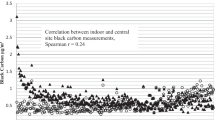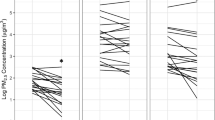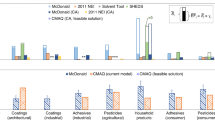Abstract
Residential indoor and outdoor fine particle (PM2.5) organic (OC) and elemental carbon (EC) concentrations (48 h) were measured at 173 homes in Houston, TX, Los Angeles County, CA, and Elizabeth, NJ as part of the Relationship of Indoor, Outdoor and Personal Air (RIOPA) study. The adsorption of organic vapors on the quartz fiber sampling filter (a positive artifact) was substantial indoors and out, accounting for 36% and 37% of measured OC at the median indoor (8.2 μg C/m3) and outdoor (5.0 μg C/m3) OC concentrations, respectively. Uncorrected, adsorption artifacts would lead to substantial overestimation of particulate OC both indoors and outdoors. After artifact correction, the mean particulate organic matter (OM=1.4 OC) concentration indoors (9.8 μg/m3) was twice the mean outdoor concentration (4.9 μg/m3). The mean EC concentration was 1.1 μg/m3 both indoors and outdoors. OM accounted for 29%, 30% and 29% of PM2.5 mass outdoors and 48%, 55% and 61% of indoor PM2.5 mass in Los Angeles Co., Elizabeth and Houston study homes, respectively. Indirect evidence provided by species mass balance results suggests that PM2.5 nitrate (not measured) was largely lost during outdoor-to-indoor transport, as reported by Lunden et al. This results in dramatic changes with outdoor-to-indoor transport in the mass and composition of ambient-generated PM2.5 at California homes. On average, 71% to 76% of indoor OM was emitted or formed indoors, calculated by (1) Random Component Superposition (RCS) model and (2) non-linear fit of OC and air exchange rate data to the mass balance model. Assuming that all particles penetrate indoors (P=1) and there is no particle loss indoors (k=0), a lower bound estimate of 41% of indoor OM was indoor-generated (mean). OM appears to be the predominant species in indoor-generated PM2.5, based on species mass balance results. Particulate OM emitted or formed indoors is substantial enough to alter the concentration, composition and behavior of indoor PM2.5. One interesting effect of increased indoor OM concentrations is a shift in the gas-particle partitioning of polycyclic aromatic hydrocarbons (PAHs) from the gas to the particle phase with outdoor-to-indoor transport.
This is a preview of subscription content, access via your institution
Access options
Subscribe to this journal
Receive 6 print issues and online access
$259.00 per year
only $43.17 per issue
Buy this article
- Purchase on Springer Link
- Instant access to full article PDF
Prices may be subject to local taxes which are calculated during checkout






Similar content being viewed by others
References
Abt E., Suh H.H., Allen G., and Koutrakis P. Characterization of indoor particle sources: a study conducted in the metropolitan Boston area. Environ Health Persp 2000: 108: 35–44.
Andrews E., Saxena P., Musarra S., Hildemann L.M., Koutrakis P., McMurry P.H., Olmez I., and White W.H. Concentration and composition of atmospheric aerosols from the 1995 SEAVS experiment and a review of the closure between chemical and gravimetric measurements. J Air Waste Manage Assoc 2000: 50: 648–664.
Birch M.E., and Cary R.A. Elemental carbon-based method for monitoring occupational exposures to particulate diesel exhaust. Aerosol Sci Technol 1996: 25: 221–241.
Brook J.R., Dann T.F., and Burnett R.T. The relationship among TSP, PM10, PM2.5, and inorganic constituents of atmospheric particulate matter at multiple Canadian locations. J Air Waste Manage 1997: 47: 2–19.
Cao J.J., Lee S.H., Chow J.H., Cheng Y., Ho K.F., Fung K., Liu S.X., and Watson J.G. Indoor/Outdoor relationships for PM2.5 and associated carbonaceous pollutants at residential homes in Hong-Kong — case study. Indoor Air 2005: 15: 194–204.
Chao C.Y.H., Tung T.C.W., and Burnett J. Influence of different indoor activities on the indoor particulate levels in residential buildings. Indoor Built Environ 1997: 7: 110–121.
Dubowsky S.D., Wallace L.A., and Buckley T.J. The contribution of traffic to indoor concentrations of polycyclic aromatic hydrocarbons. J Exposure Anal Environ Epidemiol 1999: 9: 312–321.
Fan Z.H., Lioy P., Weschler C., Fiedler N., Kipen H., and Zhang J.F. Ozone-initiated reactions with mixtures of volatile organic compounds under simulated indoor conditions. Environ Sci Technol 2003: 37: 1811–1821.
Funasaka K., Miyazaki T., Tsuruho K., Tamura K., Mizuno T., and Kuroda K. Relationship between indoor and outdoor carbonaceous particulates in roadside households. Environ Sci Technol 2000: 110: 127–134.
Geller M.D., Chang M.H., Sioutas C., Ostro B.D., and Lipsett M.J. Indoor/outdoor relationship and chemical composition of fine and coarse particles in the Southern California deserts. Atmos Environ 2002: 36: 1099–1110.
Gotschi T., Oglesby L., Mathys P., Monn C., Manalis N., Koistinen K., Jantunen M., Hanninen O., Polanska L., and Kunzli N. Comparison of black smoke and PM2.5 levels in indoor and outdoor environments of four European cities. Environ Sci Technol 2002: 36: 1191–1197.
Ho K.F., Cao J.J., Harrison R.M., Lee S.C., and Bau K.K. Indoor/outdoor relationships of organic carbon (OC) and elemental carbon (EC) in PM2.5 in roadside environment of Hong Kong. Atmos Environ 2004: 38: 6327–6335.
Jones N.C., Thornton C.A., Mark D., and Harrison R.M. Indoor/outdoor relationships of particulate matter in domestic homes with roadside, urban and rural locations. Atmos Environ 2000: 34: 2603–2612.
Kinney P., Chillrud S., Ramstrom S., Ross J., and Spengler J. Exposure to multiple air toxics in New York city. Environ Health Perspec 2002: 110 (Suppl. 4): 539–546.
Klepeis N.E., Nelson W.C., Ott W.R., Robinson J.P., Tsang A.M., Switzer P., Behar J.V., Hern S.C., and Engelmann W.H. The national human activity pattern survey (NHAPS): a resource for assessing exposure to environmental pollutants. J Exposure Anal Environ Epidemiol 2001: 11: 231–252.
Landis M.S., Norris G.A., Williams R.W., and Weinstein J.P. Personal exposures to PM2.5 mass and trace elements in Baltimore, MD, USA. Atmos Environ 2001: 35: 6511–6524.
Lee J.H., Yoshida Y., Turpin B.J., Hopke P.K., Poirot R.L., Lioy P.J., and Oxley J.C. Identification of sources contributing to Mid-Altantic regional aerosol. J Air Waste Manag Assoc 2002: 52: 1186–1205.
Li C.S., and Lin C.H. Carbon profile of residential indoor PM1 and PM2.5 in the subtropical region. Atmos Environ 2003: 37: 881–888.
Lim H.J., and Turpin B.J. Origins of primary and secondary organic aerosol in Atlanta: results of time-resolved measurements during the Atlanta supersite experiment. Environ Sci Techn 2002: 36: 4489–4496.
Lim H.J., Turpin B.J., Russell L.M., and Bates T.S. Organic and elemental carbon measurements during ACE-ASIA suggest a longer atmospheric lifetime for elemental carbon. Environ Sci Technol 2003: 37: 3055–3061.
Liu W., Zhang J., Zhang L., Turpin B., Weisel C., Morandi M., Stock T., Colome S., and Korn L. Estimating contributions of indoor and outdoor sources to indoor carbonyl concentrations in three urban areas of the United States. Atmospheric Environ 2006, accepted.
Lunden M.M., Revzan K.L., Fischer M.L., Thatcher T.L., Littlejohn D., Hering S.V., and Brown N.J. The transformation of outdoor ammonium nitrate aerosols in the indoor environment. Atmos Environ 2003: 37: 5633–5644.
Mader B.T., and Pankow J.F. Gas/solid partitioning of semivolatile organic compounds (SOCs) to air filters. 3. An analysis of gas adsorption artifacts in measurements of atmospheric SOCs when using Teflon membrane filters and quartz fiber filters. Environ Sci Technol 2001: 35: 3422–3432.
Mader B.T., Schauer J.J., Seinfeld J.H., Flagan R.C., Yu J.Z., Yang H., Lim H.J., Turpin B.J., Deminter J.T., Heidemann G., Bae M.S., Quinn P., Bates T., Eatough D.J., Huebert B.J., Bertram T., and Howell S. Sampling methods used for the collection of particle-phase organic and elemental carbon during ACE-Asia. Atmos Environ 2003: 37: 1435–1449.
McDow S.R., and Huntzicker J.J. Vapor adsorption artifact in the sampling of organic aerosol: face velocity effects. Atmos Environ 1990: 24A: 2563–2571.
Meng Q.Y., Turpin B.J., Korn L., Weisel C.P., Morandi M., Colome S., Zhang J.F.J., Stock T., Spektor D., Winer A., Zhang L., Lee J.H., Giovanetti R., Cui W., Kwon J., Alimokhtari S., Shendell D., Jones J., Farrar C., and Maberti S. Influence of ambient (outdoor) sources on residential indoor and personal PM2.5 concentrations: Analyses of RIOPA data. J Exposure Anal Environ Epidemiol 2005a: 15: 17–28.
Meng Q.Y., Turpin B.J., Polidori A., Lee J.H., Weisel C., Morandi M., Colome S., Stock T., Winer A., and Zhang J. PM2.5 of ambient origin: estimates and exposure errors relevant to PM epidemiology. Environ Sci Technol 2005b: 39: 5105–5112.
Naumova Y.Y., Eisenreich S.J., Turpin B.J., Weisel C.P., Morandi M.T., Colome S.D., Totten L.A., Stock T.H., Winer A.M., Alimokhtari S., Kwon J., Shendell D., Jones J., Maberti S., and Wall S.J. Polycyclic aromatic hydrocarbons in the indoor and outdoor air of three cities in the US. Environ Sci Technol 2002: 36: 2552–2559.
Naumova Y.Y., Offenberg J.H., Eisenreich S.J., Meng Q.Y., Polidori A., Turpin B.J., Weisel C.P., Morandi M.T., Colome S.D., Stock T.H., Winer A.M., Alimokhtari S., Kwon J., Maberti S., Shendell D., Jones J., and Farrar C. Gas/particle distribution of polycyclic aromatic hydrocarbons in coupled outdoor/indoor atmospheres. Atmos Environ 2003: 37: 703–719.
Nazaroff W.W., and Weschler C.J. Cleaning products and air fresheners: exposure to primary and secondary air pollutants. Atmos Environ 2004: 38: 2841–2865.
Offenberg J.H., Naumova Y.Y., Turpin B.J., Eisenreich S.J., Morandi M.T., Stock T., Colome S.D., Winer A.M., Spektor D.M., Zhang J., and Weisel C.P. Chlordanes in the indoor and outdoor air of three US cities. Environ Sci Technol 2004: 38: 2760–2768.
Ott W., Wallace L., and Mage D. Predicting particulate (PM10) personal exposure distributions using a random component superposition statistical model. J Air Waste Manage Assoc 2000: 50: 1390–1406.
Ozkaynak H., Xue J., Spengler J., Wallace L., Pellizzari E., and Jenkins P. Personal exposure to airborne particles and metals: results from the particle TEAM study in Riverside, California. J Exposure Anal Environ Epidemiol 1996: 6: 57–78.
Pandis S.N., Harley R.A., Cass G.R., and Seinfeld J.H. Secondary organic aerosol formation and transport. Atmos Environ 1992: 26A: 2269–2282.
Polidori A., Turpin B.J., Lim H.J., Cabada J.C., Subramanian R., Robinson A.L., and Pandis S.N. Local and regional secondary organic aerosol: Insights from a year of semi-continuous carbon measurements at Pittsburgh. Aerosol Sci Technol 2006, submitted.
Reff A. PM25 exposure assessment using FTIR spectroscopy. PhD Dissertation Rutgers University: New Brunswick, NJ, 2005.
Reff A., Turpin B.J., Porcja R.J., Giovennetti R., Cui W., Weisel C.P., Zhang J., Kwon J., Alimokhtari S., Morandi M., Stock T., Maberti S., Colome S., Winer A., Shendell D., Jones J., and Farrar C. Functional group characterization of indoor, outdoor, and personal PM2.5: results from RIOPA. Indoor Air 2005: 15: 53–61.
Robinson J., and Nelson W.C. National Human Activity Pattern Survey Data Base. USEPA: Research Triangle Park, NC, 1995.
Rogge W.F., Mazurek M.A., Hildemann L.M., and Cass G.R. Quantification of urban organic aerosols at a molecular level: identification, abundance and seasonal variation. Atmos Environ 1993: 27 (Part A): 1309–1330.
Sakai R., Siegmann H.C., Sato H., and Voorhees A.S. Particulate matter and particle-attached polycyclic aromatic hydrocarbons in the indoor and outdoor air of Tokyo measured with personal monitors. Environ Res 2002: 89: 66–71.
Subramanian R., Khlystov A.Y., Cabada J.C., and Robinson A.L. Positive and negative artifacts in particulate organic carbon measurements with denuded and undenuded sampler configurations. Aerosol Sci Technol 2004: 38 (Suppl. 1): 27–48.
Thatcher T.L., and Layton D.W. Deposition, resuspension, and penetration of particles within a residence. Atmos Environ 1995: 29: 1487–1497.
Turpin B.J., Hering S.V., and Huntzicker J.J. Investigation of organic aerosol sampling artifacts in the Los Angeles Basin. Atmos Environ 1994: 28: 3061–3071.
Turpin B.J., and Huntzicker J.J. Identification of secondary organic aerosol episodes and quantitation of primary and secondary organic aerosol concentrations during PAQS. Atmos Environ 1995: 29: 3527–3544.
Turpin B.J., and Lim H.J. Species contributions to PM2.5 mass concentrations: revisiting common assumptions for estimating organic mass. Aerosol Sci Technol 2001: 35: 602–610.
Turpin B.J., Saxena P., and Andrews E. Measuring and simulating particulate organics in the atmosphere: problems and prospects. Atmos Environ 2000: 34: 2983–3013.
USEPA. Air Quality Criteria for Particulate Matter. US Environmental Protection Agency: Research Triangle Park, NC, 2004.
Weisel C.P., Zhang J., Turpin B.J., Morandi M.T., Colome S., Stock T.H., Spektor D.M., Korn L., Winer A., Alimokhtari S., Kwon J., Mohan K., Harrington R., Giovanetti R., Cui W., Afshar M., Maberti S., and Shendell D. The relationships of indoor, outdoor and personal air (RIOPA) study: study design, methods, and quality assurance/control results. J Exposure Anal Environ Epidemiol 2004: 15: 123–137.
Weschler C.J. Chemical reactions among indoor pollutants: what we've learned in the new millennium. Indoor Air 2004: 14 (Suppl. 7): 184–194.
Weschler C.J., and Shields H.C. Potential reactions among indoor pollutants. Atmos Environ 1997: 31: 3487–3495.
Yocom J.E. Indoor-outdoor air quality relationships, A critical review. J Air Pollution Control Assoc 1982: 32: 500–520.
Acknowledgements
The RIOPA study was funded by the Health Effects Institute, the Mickey Leland National Urban Air Toxics Center, the New Jersey Center for Environmental Indicators (CEI), the NIEHS Center of Excellence, and the NJ Agricultural Experiment Station. We gratefully acknowledge the hospitality of the RIOPA participants, the hard work of all the students and technicians in the field and laboratories of the RIOPA investigators, and Marta Chicano, Eric Spring, and Sandra Lake for their valuable contributions. Research described in this article was conducted, in part, under contract to the Health Effects Institute (HEI), an organization jointly funded by the United States Environmental Protection Agency (EPA: Assistance Agreement R828112) and automotive manufacturers. The contents of this article do not necessarily reflect the views of HEI, nor do they necessarily reflect the views and policies of EPA or of motor vehicle and engine manufacturers.
Author information
Authors and Affiliations
Corresponding author
Rights and permissions
About this article
Cite this article
Polidori, A., Turpin, B., Meng, Q. et al. Fine organic particulate matter dominates indoor-generated PM2.5 in RIOPA homes. J Expo Sci Environ Epidemiol 16, 321–331 (2006). https://doi.org/10.1038/sj.jes.7500476
Received:
Accepted:
Published:
Issue Date:
DOI: https://doi.org/10.1038/sj.jes.7500476
Keywords
This article is cited by
-
Sources of indoor air pollution in New York City residences of asthmatic children
Journal of Exposure Science & Environmental Epidemiology (2014)
-
Variability in the fraction of ambient fine particulate matter found indoors and observed heterogeneity in health effect estimates
Journal of Exposure Science & Environmental Epidemiology (2012)
-
Source proximity and residential outdoor concentrations of PM2.5, OC, EC, and PAHs
Journal of Exposure Science & Environmental Epidemiology (2010)



